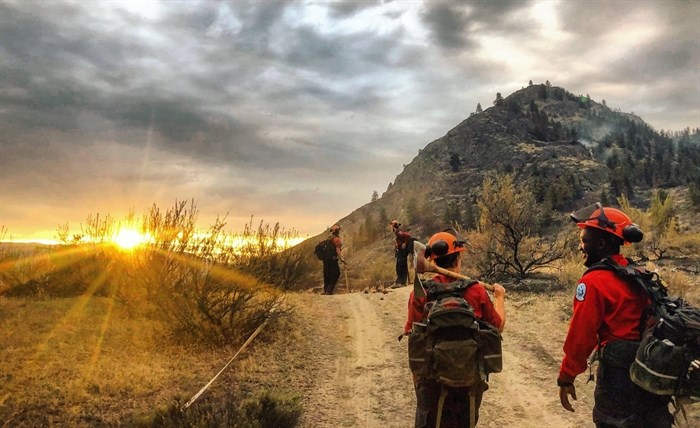
A nine-man crew is all that remains of the firefighting personnel that counted well over 100 at the height of the Eagle Bluff wildfire near Oliver, one of the Kamloops Fire District's biggest wildfires this summer.
Image Credit: SUBMITTED / B.C. Wildfire Service
August 23, 2019 - 6:00 AM
A summer weather pattern that didn’t stick to the script has nonetheless had a very positive effect on British Columbia’s wildfire season this year.
The reputation for hot, dry summers in Kamloops and the Okanagan took a bit of a hit this summer. Weather patterns brought a mix of conditions to the region, and most of the rest of the province, that included sunshine, clouds, rain and cooler temperatures.
Even so, it’s doubtful many people are complaining, especially when compared to the last two summers of extreme wildfire activity that filled the region with smoke and threatened hundreds of residents with evacuation.
B.C. Wildfire Service fire information officer Hannah Swift offered up some statistics to show what a difference the weather can make during forest fire season.
So far this year 681 fires have scorched 21,000 hectares of B.C. landscape.
Compare that with the same period in previous years.
Last year, 1,965 fires blackened 759,000 ha and in 2017 approximately 1,000 fires torched a whopping 1.2 million ha.
Swift says the $100 million spent fighting wildfires so far this year is largely recoverable, because much of that expense was due to out of province deployment, and the province will be reimbursed. That price tag compares with 2018’s year-to-date spending of $250 million and 2017’s $340 million.
Swift says you have to go back to 2016 to see similar numbers to 2019 when $96 million was spent.
She says this year’s stats are well below the 10-year averages compiled by B.C. Wildfire. According to those statistics, there are on average 1,400 fires by this date with 250,000 ha burned.
“As you can see, we’re having a much quieter year,” Swift says.
Because of the decreased activity, B.C. Wildfire has been able to dispatch more resources, including personnel, heavy equipment and aircraft to wildfires. It’s also allowed for more personnel on-site, improving training and development of staff, something that will pay off in future wildfire seasons.
“We got pretty lucky with the rain in June and July. It wasn’t so much the amount of rain as the frequency of it. We didn’t have those long periods of drying out where the deep duff was able to get extremely dry. A little bit of rain can go a long way when it’s frequent like that,” she says. The duff layer in a forest is made up of decomposing pine straw, leaves, twigs and other organic material.
Swift says many of this season’s lightning events either came with moisture or were followed by moisture, something that made lightning strikes less consequential this year.
Are people learning to be more cautious about wildfire? Swift says it’s hard to say, but normally wildfires are around 50 per cent human-caused and 50 per cent lightning-caused. However, this year lightning has caused a larger number of fires.
“We hope people are getting the message, but we’re still finding campfires left burning unattended. It’s still hard to say,” she says.
Swift says the rest of the season is looking much the same.
“We’re in a pretty good spot to finish the season without anything crazy coming up. The outlook is not too much of a concern, as there has been adequate precipitation throughout the province,” she says.
One of the largest wildfires of this season in the Kamloops Fire District is the Eagle Bluff wildfire, which is burning between Oliver and Okanagan Falls. It is seeing more demobilization of personnel and equipment this week as the fire activity decreases.
The blaze has been classified as "being held” since last week at 2,632 ha, after it was discovered on Aug. 4.
B.C Wildfire reports today, Aug. 22, there are nine firefighters remaining on scene along with a single helicopter to continue with mop-up and ongoing patrols.
There are no major fires burning in B.C. right now.
To contact a reporter for this story, email Steve Arstad or call 250-488-3065 or email the editor. You can also submit photos, videos or news tips to the newsroom and be entered to win a monthly prize draw.
We welcome your comments and opinions on our stories but play nice. We won't censor or delete comments unless they contain off-topic statements or links, unnecessary vulgarity, false facts, spam or obviously fake profiles. If you have any concerns about what you see in comments, email the editor in the link above.
News from © iNFOnews, 2019